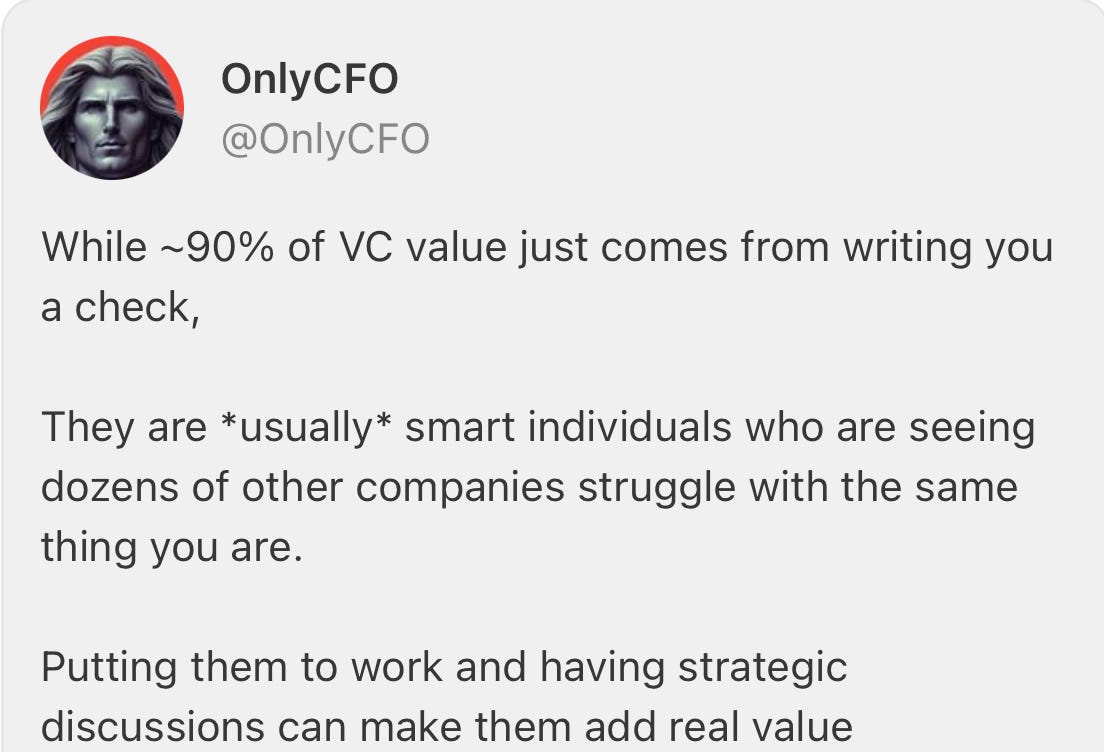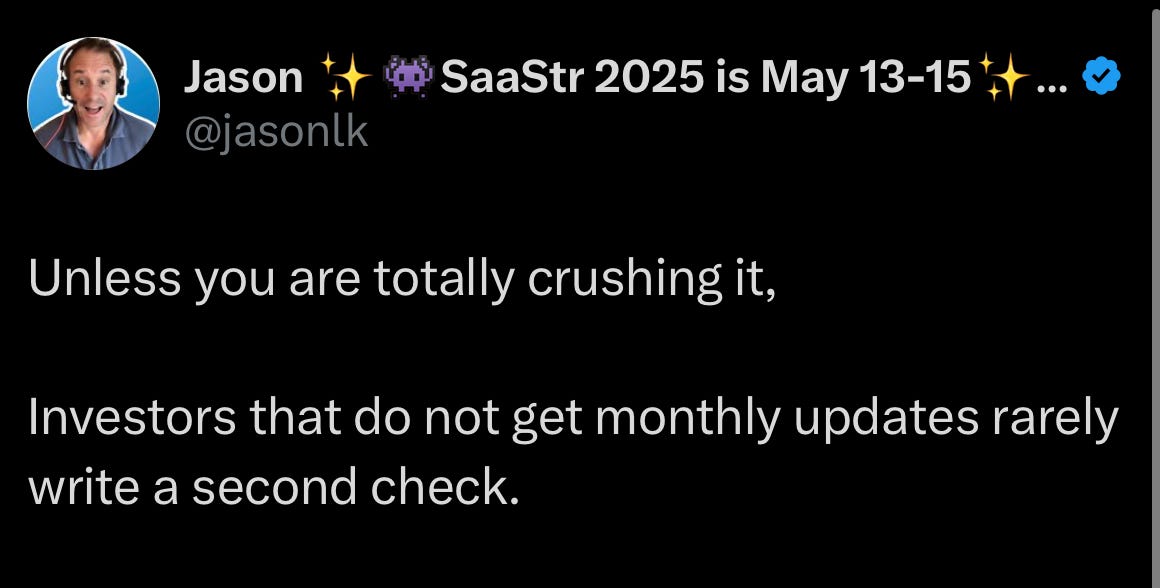Board Meetings That Don't Suck
Board meetings and investor relations can be LOTS of work for a company. If managed properly though they can be a big value add and not a waste of time.
Today’s Sponsor: Leapfin
New Data: State of Accounting Automation
The results are in! Check out this new data from Leapfin’s State of Automation for Revenue Accounting Report. See the results from surveying ~300 finance and accounting operators:
Learn who’s leading in automation adoption and how you compare
See how your peers are using automation
Get insights to shape 2025 planning
My First Board Meeting Was Terrible
I was a bit nervous when I attended my first board meeting and I didn’t really know what to expect. Being in finance I had been involved with creating board materials and I would hear from my boss about what was discussed, but I didn’t *really* know the environment inside of the boardroom.
For this particular board meeting the company had prepared a 100+ slide deck and all the company leaders were well-rehearsed on their parts.
We managed to get through the whole deck in 2.5 hours. There wasn’t a single question from the Board. In fact, they only said about 10 words in total - “makes sense”, “great”, “good job”, etc. When we left the boardroom, the management team proceeded to give each other high fives and tell each other how great it went.
My reaction of the board meeting was a little different:
What did we just accomplish? All we did was present the same facts that were in the pre-read material. This meeting could have been an email. I thought board members were supposed to add value….
The problem was that we just provided a really long update to the board and nothing else. The reason there were no questions/discussions is because there was no time! People were clearly exhausted after 2.5 hours of presentation and just wanted to go home.
Board meeting time falls into one of the below types:
Updates - Providing updates on the business (CFO showing financials)
Approvals - Seeking board approval (CFO getting the annual plan approved)
Discussion - Strategic conversations with the board (pricing strategy)
This terrible board meeting was 2.5 hours of updates with no discussions before or after the board meeting. If a company wants the actual board meetings to be only #1 and #2, I think that is fine. But keep the board meeting fairly short.
However…the strategic board discussions should be happening somewhere.
Managing Your Board
Board preparation and investor relations is A LOT of work. There is certainly value the management team gets themselves from going through the exercise, but don’t waste your opportunities with your board.
Even if you think board members don’t provide helpful advice, they do provide one of your most important resources: Cash.
And if you manage your board poorly, then they won’t trust you. Not only will they not give you more cash in the future but it will be much harder to get money from other investors if your current ones don’t trust you.
The actual board meeting is just one part of successfully managing your board and getting real value from your board members. Below are some of the interactions you should be having with your board.
1. Investor Update
The company should be sending either a monthly or at least quarterly update to the board within 48 hours after the end of each period.
You lose investor trust by not providing regular updates. If companies aren’t providing regular updates, investors usually assume that things are going very well…
The investor updates can be a quick email that focuses on the highlights:
Cash balance and cash runway
ARR growth
Churn
Notable new logos and churn
How sales pipeline is looking for the next quarter
Anything else significant worth calling out (limit to 2-3 items)
The board does not want to wait 3 weeks after the end of the quarter to hear that you missed sales targets by 50% and expect to miss next quarter by 50% as well. Don’t wait to update your board with bad news!
The number 1 rule with managing your board is NO SURPRISES. Experienced leaders are not afraid to be honest with their board. The truth will come out at some point so you might as will build trust by being transparent.
2. Investor Pre-Meetings
As I said earlier, the number one rule for board meetings is no surprises. This doesn’t mean everything has to be completely vetted out and discussed before a board meeting, but you don’t want to present something potentially controversial for the first time in the meeting.
These pre-meetings are separate meetings with each individual board member. On the company side, they would include the CEO and potentially another executive depending on the topic. For example, if you are seeking approval of the annual plan in the board meeting then the CEO and CFO can meet with each board member individually to go through the plan before the board meeting presentation/approval.
3. Board Meeting Pre-Read Materials
Timing: Send the materials at least 48 hours in advance. If you are sending materials at midnight the night before then board members don’t have a chance to review them before the meeting, which makes the meeting much less productive.
Pre-read content: Most companies follow one of the below methods with regard to pre-read materials. Both options work, but I have a strong preference for option #2 because with a long-form narrative format the management can better convey the story and make the actual board meeting more productive.
Option 1: The pre-read material is the exact same as the board deck that is presented in the board meeting.
Option 2: The pre-read material is a long-form narrative (or more detailed deck) and what is presented is a condensed slide deck to help tee off discussion items.
Request for questions and comments: Ask your board to provide questions/comments on the pre-read materials before the meeting. Telling your board to provide questions ahead of time will do two things:
Helps make sure your board reads the materials in detail before the meeting
Gives the board time to ask the questions most important to them, which will help drive the board discussions.
4. The Board Meeting
CEO’s State of the Union
This is an opportunity for the CEO to review the state of the company at a high level. I like the below format for the first slide to guide most of this conversation.
Other areas that the CEO update can cover include:
Company’s top priorities for the quarter/year
Strategic learnings from the past quarter
Any changes to product or GTM strategy
After these high-level updates, the CEO (or could be the CFO) should present some of the north-star data/metrics to set the context for the meeting. For startups, the two most important topics are usually 1) annual recurring revenue (“ARR”) and 2) cash runway.
The CEO should cover high-level topics and other strategic topics, but the department specific details is usually better left for the department leaders.
Go-to-market (“GTM”) Update
Given the importance of sales growth for VC-backed software companies, a GTM update should be in every single board meeting. The focus of the GTM update will shift during different stages of the business though.
During the early phases of a company, new logo growth is king. But as the company builds a significant customer base then customer success (gross and net retention) becomes increasingly important. Similarly, if the company has faced pipeline problems then marketing might be a major focus.
Some items that should be considered in this update:
Previous quarter summary: Significant deals closed, why the company beat/missed plan, win/loss analysis, churn summary, etc. Remember to provide context!
Current quarter outlook: Current forecast vs plan, pipeline coverage, new channels, significant deals in the pipeline, customer churn risk, etc
General outlook: There are a lot of potentially interesting analyses that can be done to provide insight into how GTM is performing, the trend, and what it means for the future. Figure out what is most meaningful to your company and don’t be afraid to ask the board what they want to see.
Finance
Every board update should include a financial review. The focus and time spent on financial review will change at different stages of the company.
Early Stage: Revenue growth is everything with an eye toward cash runway
Mid-Stage: Revenue growth AND efficiency
Late-Stage: Revenue growth, getting to profitability, and GAAP financials
Importance of revenue growth and related metrics never goes away for VC-backed companies because it is required for venture math to work. But as you grow, GAAP financials increase in importance.
Other Executive Leader Updates
The executive team should get exposure to the board. The board likes to hear directly from the department leaders because they are the ones running their functions and are better equipped to engage in discussions.
However, if you let every executive present at every board meeting then it will quickly turn into a 5 hour, unproductive meeting. Not every area needs to be covered live at every meeting.
Decide what items are critical to discuss with the board at each meeting, but make sure you allow each leader to occasionally present.
Closed Session
This is where everyone except the CEO and board members are kicked out of the room so they can discuss more confidential items. The CFO may stick around for part of the closed session if equity or finance matters are being discussed.
What is discussed in this secretive meeting?
Mostly boring stuff, but here are a few items that are routinely discussed in the closed session meeting:
Approval of 409A valuation reports and employee equity grants
Review and feedback on executive team performance
Sensitive topics such as potential layoffs, bonus plan approvals, M&A, executive staff changes, etc
6. After the Board Meeting
Board dinner: There are differing views on whether this should be before or after the board meeting. I don’t think the timing matters all that much, but it seems more relaxed and open when done after the board meeting.
Feedback request: Ask the board occasionally what went well and what could have gone better. Board members are in lots of board meetings, so they likely have some feedback on things other companies are presenting/discussing that they want to see.
Follow-up items: Summarize the action items from the board meeting so the management team can review and take appropriate action. As appropriate send the summary and responses to the board as well.
Working group sessions: Your board members *usually* want to help you, but some topics/discussions are best done outside of the full board meeting with a smaller group. Board members come from various backgrounds - operating, finance, previous founder, etc. Understand their expertise and create working groups with them to discuss strategic topics.
Other Thoughts
Context is critical: A board slide with only the most recent quarter’s numbers is not very helpful. Board members don’t remember the company plan, the historical numbers, or the details of your previous company objectives. They work with a lot of companies. Provide the relevant context in the board material so they know how to interpret the data.
Control the conversation. Don’t let a board member (and especially a board observer) derail a board meeting. Make sure to control the meeting and have the discussions you think are the most important. You can always sync with board members outside of the meeting.
No Surprises: This is why investor updates, pre-read materials, and pre-meetings are so important. Do not surprise board members in the meetings with a controversial topic.
More discussion less review: Dave Kellogg has a great blog post on this topic. Like my first board meeting story, board meetings are frequently too heavily on reviewing the past and not on the future. The reason I like detailed pre-reads is so the board meeting can be more focused on strategic topics and getting advice from your board members. I bet almost all companies would benefit by adding more discussion time vs review time in their board meetings.
Length of the Meeting: For most private companies, the answer is likely 1.5 - 2.5 hours. As complexity increases with agenda items such as M&A, fundraising, managing a tight cash runway, etc, the meeting might be on the longer side. Once you are public, board meetings always take longer because there is a lot more complexity and administrative matters.
Final Thoughts
Make your VCs and the board meetings a value add. Don’t view them as a checklist item to just simply complete every quarter. If you manage your board correctly then there will be real value created.
And if you truly think your Board is completely useless (they are good for the money and nothing else)…you should still do the above things. Why? Because your board members will at least trust you so when you need more money, they are more willing to write another check :)
Footnotes:
Sign up for the OnlyCFO webinar series! Our first one is on how your annual planning might break in 2025.
Send an email to onlycfo@onlycfo.io if you want to be a sponsor of the OnlyCFO newsletter or my new webinar series. Get in front of 28K+ finance/accounting professionals
Check out OnlyExperts to find offshore accounting resources. They have some amazing talent for 20% the cost of a U.S. hire.









Another great post (as always).
After 17 years, five startups, and countless board meetings as a CEO, COO, and CRO, I am trying to remember a single time when we left the board meeting with new, useful ideas for growing and running the business. As you say, it may have been how we structured the meetings. However, in my experience, most boards have low value-add.
One good thing about board meetings is that they force the exec team to regularly step back and take stock of where they are going and how they are doing. Despite the disruption board prep causes, it's an important exercise.